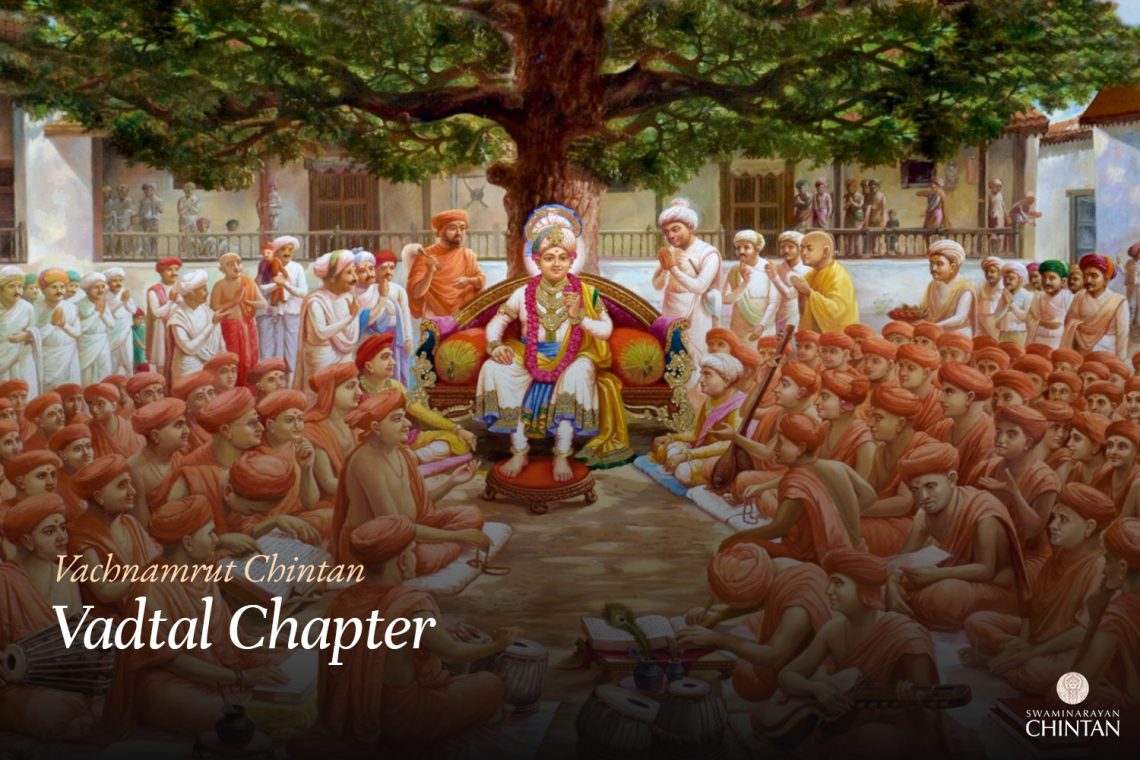Central Insights:
- The means for achieving the (kalyan) ultimate salvation of the soul.
Key Points:
- When Bhagwan incarnates on Earth, either in the form of a king or a sant, the soul can achieve ultimate salvation by recognizing His form and seeking His refuge.
- By recognizing an ekantik sant (a saint who embodies all virtues) and abiding by his commands, as well as those of Bhagwan, the soul can attain kalyan.
- Even in Bhagwan’s absence, kalyan can be achieved through firm faith in His murti and by practicing bhakti with adherence to dharm.
Explanation:
In this Vachanamrut, a Patidar named Bhagubhai from the village of Bhadaran asked Maharaj, “Maharaj, how can the jiva (soul) achieve kalyan?” In response, Maharaj explained that when Bhagwan incarnates on Earth, the soul’s kalyan can be attained by taking refuge in Him, surrendering to Him, abiding by His commands, and performing bhakti. When Bhagwan is not physically present, one should seek refuge in a true sant who has met Bhagwan. By following this sant’s guidance and living according to Bhagwan’s commands, one can also achieve kalyan. If one cannot find such a sant, one should develop firm faith in Bhagwan’s murti, remain devoted to swadharm (one’s own duty), and engage in bhakti, for this will also lead to kalyan. Thus, Maharaj provides three progressive alternatives.
Here, Maharaj elaborates on Bhagwan’s incarnations, explaining that His manifestations differ depending on whether He appears as a king or as a sant. In the form of a king, Bhagwan possesses the 39 auspicious virtues, including satya (truthfulness) and shauch (purity). When manifested as a sant, He embodies 30 qualities, such as krupaluta (compassion) and drohrahitata (absence of enmity). Meeting such an incarnation and recognizing Him is essential. During times of Bhagwan’s incarnation, many had the opportunity to meet Him, yet only a rare few truly recognized Him. Therefore, the process of meeting Bhagwan followed by recognition is kalyan itself. Simply meeting Bhagwan certainly leads to benefit, but it is not enough. Once recognition is attained, complete kalyan can be understood as achieved. When Bhagwan incarnates with qualities such as krupaluta, identification remains vital.
In the teachings of Sadguru Gunatitanand Swami, it is mentioned that kalyan for the soul is due to these 30 or 39 qualities, not due to miracles, marvels, or displays of majesty. For the jeev, achieving kalyan lies in recognizing Bhagwan and establishing an eternal bond with Him; mere meeting is not sufficient. Thus, true recognition of Bhagwan leads to ultimate kalyan, while mere physical presence does not. Once true recognition occurs, the jeev forges a bond of refuge, which becomes the basis for kalyan. In recognition, Bhagwan’s presence is visible beyond His 39 kingly qualities or 30 saintly virtues, radiating His divinity and benevolence. The essence of Bhagwan, described as कल्यााणैैकतानता — kalyāṇaikatānatā (focus on the welfare of others) and हेयप्रतिभट्टता— heyapratibhaṭṭatā (ever opposed to harm/flaws/wrong), is seen through His interactions, both in His pastimes and behavior. This truth is known in the soul’s heart by the yearning for kalyan. Trying to discern with a checklist of qualities will not lead to recognition; it will only lead to misdirection.
Maharaj emphasizes that in practical life, these two forms manifest differently. As a king, Bhagwan demonstrates majesty, authority, and a unique compassion. As a sant, Bhagwan exhibits wisdom, austerity, and an exceptional benevolence. However, both forms exhibit attributes such as satyasankalpata (truthfulness in resolve), kalyan for those who surrender, and reverence for the shastras (scriptures). If one recognizes either form of Bhagwan, seeks refuge in Him, adheres to His commands, and performs bhakti, then the soul achieves kalyan. Maharaj also adds that even when Bhagwan is not physically present on Earth, ekantik sants always remain. By seeking refuge in such sants, following their commands along with Bhagwan’s, and performing bhakti, the soul attains kalyan. Here too, the recognition of the sant’s saintliness is central to the soul’s kalyan. Simply living in their presence does not suffice for achieving ultimate liberation. If one cannot encounter such a sant, then by developing unwavering faith in Bhagwan’s murti, practicing dharm, and engaging in bhakti, the jeev still reaches kalyan.
Glossary
| Kalyan – liberation from the cycle of birth and death and reaching divine abode of God. |
| Ekantik Sant – Single-minded Saint of Bhagwan |
| Murti – Divine form of God Refers to Bhagwan’s physical or imagined divine form, which provides joy and spiritual connection during contemplation. |
| Swadharm – One’s own moral and spiritual duties |
| Krupaluta – Compassion One of the 30 key saintly qualities that helps devotees recognize Bhagwan or a true sant. |
| Satyasankalpata – Bhagwan’s attribute of unwavering commitment to His purpose and promises, always acting in truth and integrity. |
| Kalyaanaikatanataa – Constant focus on the kalyan (welfare) of others A unique divine quality of Bhagwan that signals His supreme benevolence and is key in recognizing Him or His true saint. |
| Heyaprati-bhattata – Opposition to flaws or wrong Bhagwan’s inherent opposition to harm, flaws, or wrong actions, highlighting His benevolent and corrective nature. |
| Bhakti – Devotion Loving and selfless worship of God. |
| Ashray – Refuge Seeking shelter in Bhagwan or His true sant Taking spiritual refuge through surrender and adherence to their commands, leading to kalyan. |

